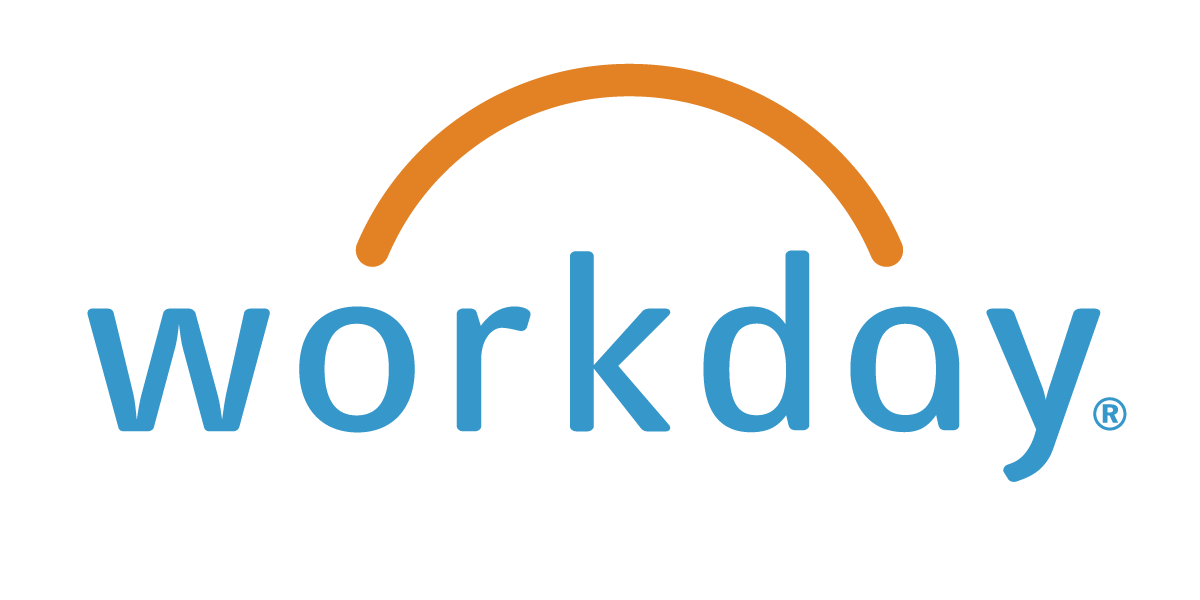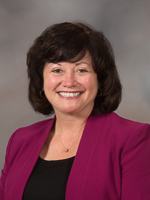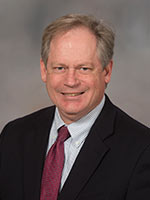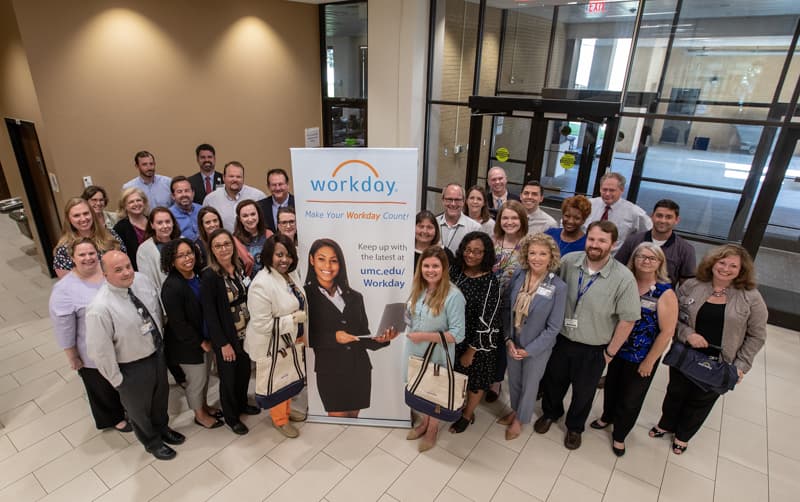Enterprise resource conversion represents dawn of new Workday

Starting today, University of Mississippi Medical Center employees will access their biweekly paychecks, record their personal leave time, submit travel reimbursements to accounting, record “qualifying life event” changes impacting benefits and apply for other positions at the institution – among other everyday functions – in a brand new way.
The first phase of the implementation strategy for Workday, the institution’s new Enterprise Resource Planning system, took place at midnight when all human resources and payroll and some aspects of finance were fully converted from the legacy Lawson system.
Future rollouts of supply chain management (by close of 2019), student recruiting and admissions (by June 2020) and student records, curriculum management and financials (by close of 2021) will complete the transition of the institution’s Lawson and Student Information Systems products into Workday.
According to Paula Henderson, chief human resources officer, the much anticipated transition will have a dramatic impact on employees and students.

“Life as we know it will be completely different,” Henderson said. “When fully deployed, Workday will represent the largest and most comprehensive ERP in the history of the Medical Center.”
UMMC initially announced it would transition its ERP system in February 2018. Lawson had served as the Medical Center’s ERP vendor since 2005 and Student Information Systems had originated at UMMC in 2007.
The institution’s contract with Lawson was about to expire, and Workday represented a highly rated alternative used by several leading technology research companies and academic medical centers that could shoulder the workload of both Lawson and SIS.
Although the overall cost for Workday was greater – original UMMC estimates indicated as much as $100,000 more per year – the new ERP system allowed the institution to retire a number of applications.

“Workday will be the foundational system operations support for the entire institution,” said Sam Smith, UMMC chief accounting officer-comptroller. “It’s not limited just to certain aspects of our business operations.”
The Medical Center originally unveiled an ambitious goal of implementing the first phase of Workday by Jan. 1, 2019, but last December, that deadline was extended to today.
“We had a very compressed timeline and we felt it would be better to wait and make sure we had a good go live rather than try to achieve a deadline and have a poor go live,” Smith said. “There was additional testing that needed to be done and we needed to feel more confident with certain primary functions, such as payroll.
“As we approached the July 1 go live, there wasn’t nearly as much angst or sense that we’re not ready. It was better to have confidence that we would be successful with the rollout.”
He said the delay, among other benefits, allowed UMMC’s Workday Implementation Team additional time to offer training for UMMC employees.
“We were able to develop more resources and select a group of about 30 employees knowledgeable about current business processes and how they would change with Workday into the organization as ‘change ambassadors,’” Smith said. “These subject matter experts, directors and leaders in their departments serve as Workday communications liaisons helping employees get ready for Workday and some were able to participate in various elements of testing and building the training modules.”

Ellen Swoger, chief information officer-applications in the Division of Information Systems, said this first phase of the ERP conversion will impact all UMMC employees and students who also work at UMMC.
“When complete, the rollout will touch every corner of this institution,” Swoger said. Until then, she said supply chain management functions, such as purchase requisitions, purchase orders, vendor agreements, accounts payable, property control, inventory control and other accounting items, will continue to be performed in Lawson.
While the purpose of the ERP transition is to improve efficiency and overall cost, Smith said the first thing employees may notice about Workday is its ease of use.
“The user interface is more intuitive with this product,” he said. “With Lawson, you had to have a list of bookmarks or you needed to know a specific search term.”
“It’s a much more modern, contemporary user interface than what was on the legacy system,” Swoger said. For example, “You click on a picture to get to an expense report compared to a box that says ‘Expense Report Processing.’”
“It’s really a modern system. It’ll change the culture, I think.”
Accompanying the improved interface are slight differences in what certain categories and functions are called.
“There’s new terminology with a new lexicon in Workday,” Smith said. “Some specific accounting class numbers will be different, too. So it’s important for employees to become familiar with these differences.
“An example of lexicon differences is the term ‘Budget Account’ in Lawson: It is now ‘Ledger Account’ in Workday. ‘Accounting Unit’ will now be ‘Cost Center.’ And so on.”
Jargon differences aside, the new system promises to streamline tasks that sometimes took days to complete.
“People used to complete physical forms – now they will complete them in Workday,” Henderson said. “For example, for life event changes, such as a marriage, you had to complete a form and submit it be email. Now you will complete it and submit it, all in Workday.
“Hopefully it’ll be more efficient and requests will be handled faster.”
“Workday keeps up with paperwork processes so much better,” Swoger said. “You don’t have packets of paper waiting for someone to review and sign. It’s fabulous!”
Workday delivers version upgrades twice per year (March and September) and all customers, no matter what industry, are on the same version. In addition to these upgrades, patches and enhancements are pushed out on a weekly basis, ensuring the latest functions and features are available with the least possible downtime.
“July 1 is just the starting point of this journey,” Swoger said. “We’re going to optimize it and do even more with it as we move forward.”
The fact that the new ERP system is being used by a vast array of industries – not just health care or higher education – gives Workday Implementation Team members confidence that this is the right solution for the Medical Center.
“This is an international product delivered by a company with over $2 billion in annual revenues and a value of almost $10 billion at their initial public offering,” Smith said. “It's not some boutique thing. The company was founded by the former CEO and the former chief strategy officer of Peoplesoft.
"What we’re implementing now will be foundational for the next 10 years or more. It’s an investment for the foreseeable future.”
“Everyone says once they’re through with the implementation process, it’s quite an improvement,” Henderson said. “And they don’t want to go back.
“It’s likely there’s still a good deal of training needed for our employees. The training will help people become more prepared to do their business processes in Workday.”
Workday learning resources for employees, including in-person classes, short videos, job aids and self-paced online modules through HealthStream, will continue to be available in various forms throughout the life of Workday at UMMC. A learning resources icon available on the Workday application homepage links users to job aids, videos and frequently asked questions. UMMC’s Workday Training Team will keep these resources up to date with the current version of Workday.
Workday at a glance
* Who is impacted by today’s Workday implementation?
All Medical Center employees and all Medical Center students who are also UMMC employees.
* What has changed today?
Certain human resources, payroll and finance functions – such as employee leave time, benefits, recruiting, payroll and travel expenses – have been transitioned from Lawson to Workday.
* What remains to be done?
Conversion of supply chain management from Lawson to Workday is scheduled to take place by the end of 2019. Conversion of the student admissions module from the Student Information System to Workday is scheduled to take place by June 2020. Conversion of all remaining Student Information System functions to Workday is scheduled to be completed in phases by May 2021.
* What should I do now?
Employees should check their email inbox today for a “Day 1 Checklist,” that will take them through Workday step-by-step and show them how to log in, find information and make updates. Online training will continue to be available through HealthStream through Sept. 28. A learning resources icon is available in Workday, and open labs can be scheduled with the Division of Information Systems. Finally, for the next two weeks, DIS will offer a Workday Command Center for telephone inquiries about Workday at 4-1145.

Members of the Workday Implementation Team celebrate this morning’s launch of the first phase of UMMC’s new Enterprise Resource Planning system. Team members include, at left from back, Ellen Swoger, chief information officer-applications; Brian Shaw, senior information technology program manager; Al Faulk, senior director of information technology; Megan Wylie, human resources business partner; Pam Melzer, director of benefits; John Wood, senior compensation analyst; Chris Moulds, senior business systems application coordinator/analyst; Tommy Sullivan, director of compensation; Rebecca Keefer, human resources business partner; Melissa Nielsen, Workday trainer; Julie Green, information technology program manager; Logan Garner, senior clinical systems application coordinator/analyst; Cathy Holloway, Workday release coordinator; Chris Morgan, senior human resources service partner-employee relations and compliance; Laura Belser, talent acquisition manager; Carla Holifield, human resources business partner; and Cecelia Bass, employee relations director; and right side from back, Larry Bouchea, director of human resources service center and talent acquisition; Sam Smith, chief accounting officer/comptroller; Laura Savage, SCI project manager; John Lisenbe, human resources service center manager; Paula Carter, property control manager; Hartman Holliman, director of the Information Technology Project Management Office; Kidada Rice, treasury management director; Matthew Fowler, SCI contractor; Margaret Prine, associate comptroller; Susan Turner, assistant comptroller; Loisteen Issac, purchasing and inventory coordinator; Glenda Bailey, intermediate information technology project manager; Jason Dill, accounting supervisor; Paula Drake, intermediate business systems application coordinator/analyst; and Paula Henderson, chief human resources officer.


